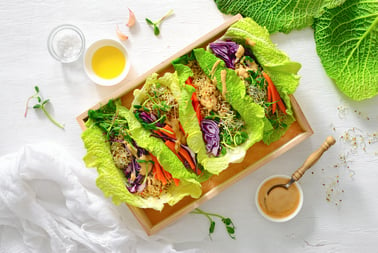 St. Patrick’s Day is just around the corner! While many associate the holiday with green beer and festive celebrations, let’s shift the focus to something else that should be green—your plate! Whether you’re hitting the gym for strength training, cardio, or Olympic lifting, what you eat plays a major role in your performance and recovery. This March, take a lucky approach to fueling your workouts with nutrient-dense foods that keep you strong and energized.
St. Patrick’s Day is just around the corner! While many associate the holiday with green beer and festive celebrations, let’s shift the focus to something else that should be green—your plate! Whether you’re hitting the gym for strength training, cardio, or Olympic lifting, what you eat plays a major role in your performance and recovery. This March, take a lucky approach to fueling your workouts with nutrient-dense foods that keep you strong and energized.
Go for the Greens
Leafy greens like spinach, kale, and Swiss chard are not only a festive addition to your plate but also packed with vitamins and minerals that support muscle function and endurance. Magnesium, found in abundance in greens, helps with muscle contraction and energy production. Add a handful of spinach to your pre-workout smoothie or toss some kale into your post-workout meal for an extra boost.
Potatoes: A Performance Powerhouse
Potatoes—whether white, gold, or sweet potatoes—are an excellent carbohydrate source to fuel your training. Carbs replenish glycogen stores, which is crucial for endurance and strength athletes alike. Pair roasted potatoes with a lean protein source like chicken or tofu for a well-rounded post-workout meal.
Lean into the Luck of Protein
Corned beef might be a holiday staple, but for daily muscle recovery, opt for leaner protein choices like turkey, chicken, eggs, or plant-based options like lentils and chickpeas. Protein helps repair muscle tissue and supports overall strength gains. Try making an Irish-inspired meal with salmon and roasted vegetables for a protein-packed, omega-3-rich post-workout dinner.
Hydration: More Than Just a Pint
Let’s not forget hydration. With workouts, sweat loss, and the potential for St. Patrick’s Day festivities, staying hydrated is key to performance and recovery. Water should always be your go-to, but if you need extra electrolytes, consider adding coconut water or a pinch of sea salt to your water bottle to maintain fluid balance.
A Post-Workout Shamrock Shake (The Healthy Way!)
Skip the drive-thru and make your own protein-packed Shamrock Shake:
Ingredients:
- 1 cup unsweetened almond milk
- 1 frozen banana
- 1 scoop vanilla protein powder
- ½ avocado (for creaminess)
- A handful of spinach (for that natural green color!)
- ½ teaspoon peppermint extract
- Ice cubes as needed
Directions:
Blend until smooth, and enjoy a refreshing, nutrient-dense recovery shake!
Whether you're training for strength, endurance, or general fitness, nutrition is your pot of gold at the end of the workout rainbow. By focusing on whole foods, proper hydration, and smart recovery choices, you’ll keep your energy levels up and your performance on point.
This St. Patrick’s Day, fuel your body wisely—because the real luck comes from good habits and consistency in your training and nutrition!
Looking to stay on track all year long? Schedule an appointment with a Nutrition Coach today—they’re here to help you reach your goals every step of the way!


 As the Super Bowl approaches, it’s time to gear up for one of the most exciting nights of the year.
As the Super Bowl approaches, it’s time to gear up for one of the most exciting nights of the year.  Pack Portable, Balanced Snacks
Pack Portable, Balanced Snacks
 The holiday season is here, and Thanksgiving often marks the beginning of celebrations focused on family, food, and gratitude. While it’s a time to enjoy yourself, it can also present challenges if you’re trying to stick with healthy habits. The good news is that you don’t have to choose between enjoying the holiday and maintaining your wellness goals. With a few thoughtful approaches, you can do both!
The holiday season is here, and Thanksgiving often marks the beginning of celebrations focused on family, food, and gratitude. While it’s a time to enjoy yourself, it can also present challenges if you’re trying to stick with healthy habits. The good news is that you don’t have to choose between enjoying the holiday and maintaining your wellness goals. With a few thoughtful approaches, you can do both!.jpg?width=422&height=281&name=GettyImages-1423997728%20(1).jpg) In the realm of fitness and nutrition, the term "caloric deficit" often takes center stage. But what exactly does it mean, and why would someone actively pursue it? Let's break it down.
In the realm of fitness and nutrition, the term "caloric deficit" often takes center stage. But what exactly does it mean, and why would someone actively pursue it? Let's break it down.
 Summer is the perfect time to rejuvenate not only your spirit but also your diet. The warmer months bring an abundance of fresh produce, longer days, and a general sense of renewal, making it an ideal time to experiment with new nutritional habits. Here’s how you can make the most of summer by trying new things in your diet.
Summer is the perfect time to rejuvenate not only your spirit but also your diet. The warmer months bring an abundance of fresh produce, longer days, and a general sense of renewal, making it an ideal time to experiment with new nutritional habits. Here’s how you can make the most of summer by trying new things in your diet.


.jpg?width=480&height=309&name=GettyImages-1448979924(2).jpg) In today's fast-paced world, where new diet trends and health fads emerge almost daily, it can be challenging to discern what truly benefits our bodies. Amid this whirlwind of ever-changing advice, the key to a healthier life may not lie in exotic superfoods or rigorous diet regimens, but in the consistent practice of nutritional basics.
In today's fast-paced world, where new diet trends and health fads emerge almost daily, it can be challenging to discern what truly benefits our bodies. Amid this whirlwind of ever-changing advice, the key to a healthier life may not lie in exotic superfoods or rigorous diet regimens, but in the consistent practice of nutritional basics.

 Grilled Zucchini Hummus Wrap
Grilled Zucchini Hummus Wrap  Chicken and Cucumber Lettuce Wraps with a Simple Peanut Sauce
Chicken and Cucumber Lettuce Wraps with a Simple Peanut Sauce  It’s no secret that our emotions impact what we eat, when we eat, and how much we eat. In fact, sometimes it seems that the strongest cravings hit when our emotional and mental well-being is at its weakest. Emotional eating is a way to, in the short term, relieve or suppress negative feelings, such as sadness, stress, anger/frustration, or boredom. However, emotional eating can also lead people to make poor choices, such as skipping or forgetting meals, consuming fast food frequently, or consuming alcohol or caffeine in excess, all of which may have health consequences, including unintentional weight gain.
It’s no secret that our emotions impact what we eat, when we eat, and how much we eat. In fact, sometimes it seems that the strongest cravings hit when our emotional and mental well-being is at its weakest. Emotional eating is a way to, in the short term, relieve or suppress negative feelings, such as sadness, stress, anger/frustration, or boredom. However, emotional eating can also lead people to make poor choices, such as skipping or forgetting meals, consuming fast food frequently, or consuming alcohol or caffeine in excess, all of which may have health consequences, including unintentional weight gain.